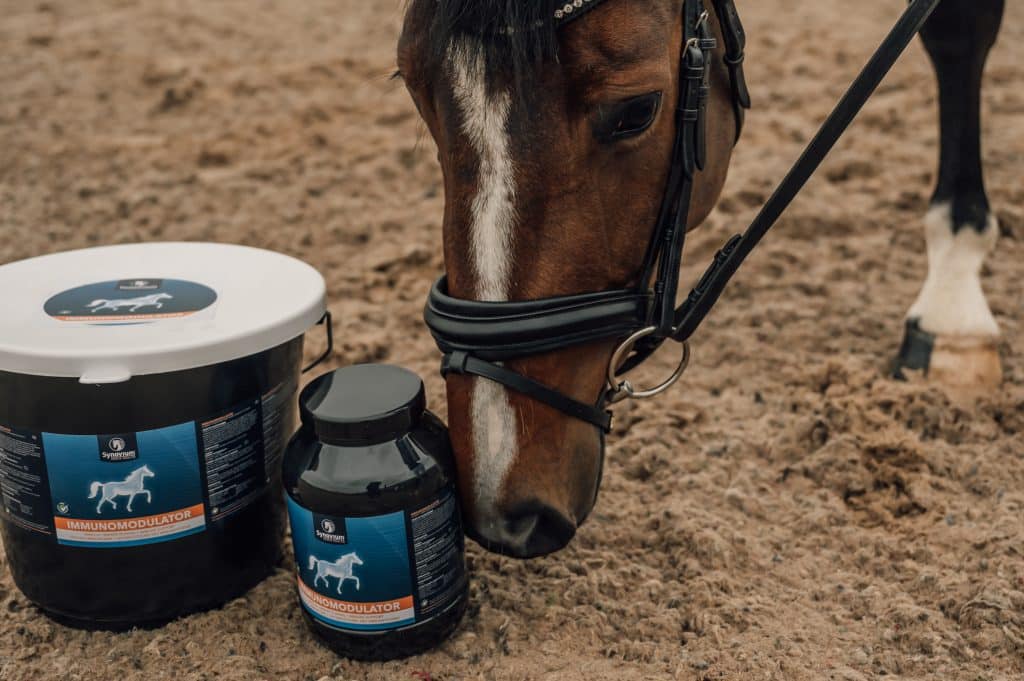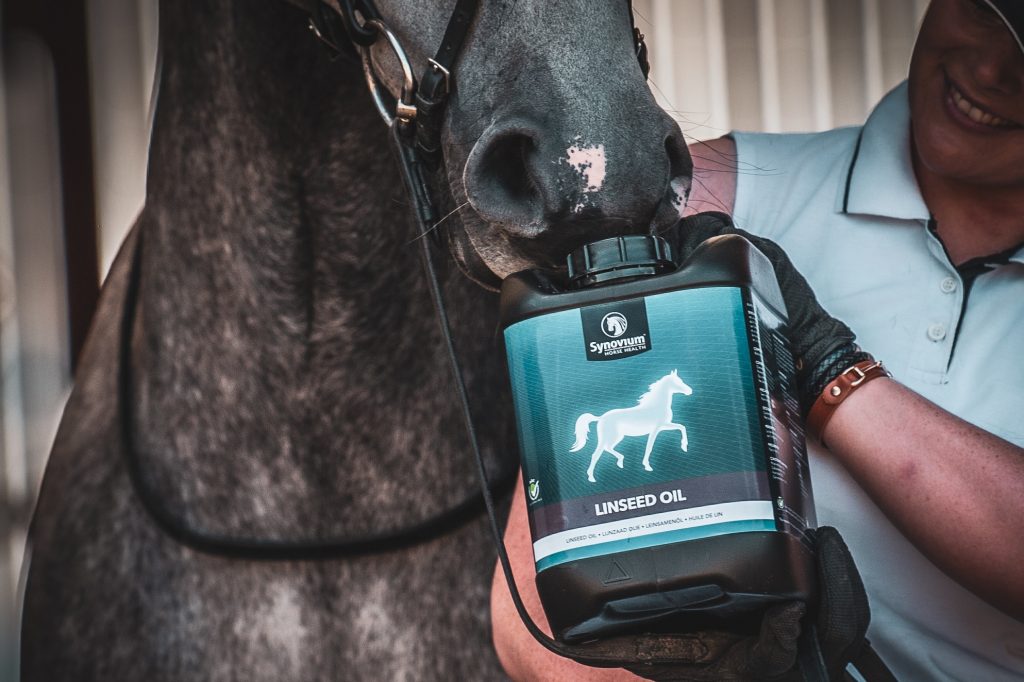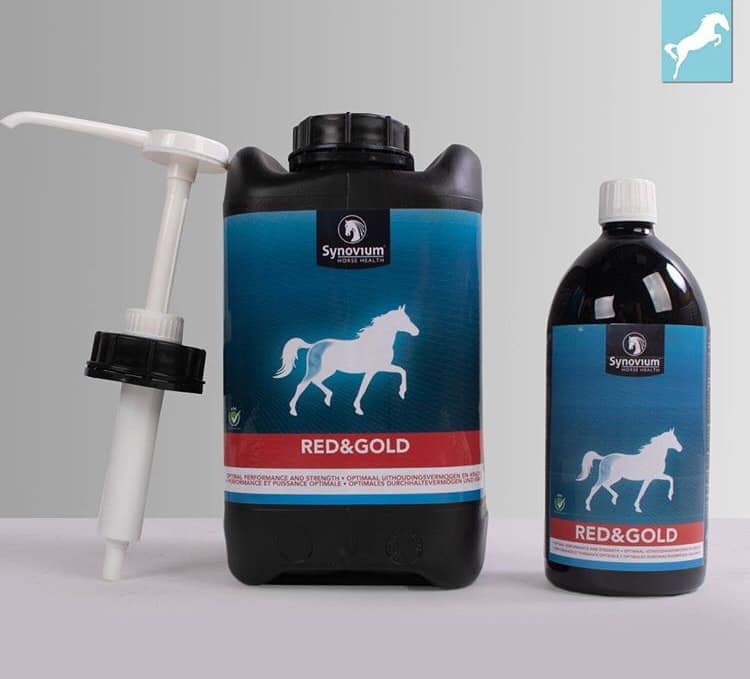Posted: 9th July 2024 | Back to news feed


A diet is formulated according to the horse’s daily nutritional needs. A balanced diet is formulated to meet these needs, containing energy, proteins, vitamins and minerals important for the body. One of the most important nutrients in the diet is energy.
Energy is required for body maintenance and metabolic processes. Besides, it is used as fuel for the body when the horse exercises. Dietary energy is provided by adding carbohydrates and fatty acids to the diet. Protein can also be used as a form of energy, but the body only uses it when the diet does not contain enough carbohydrates and fats.
CARBOHYDRATES
Carbohydrates are divided into two groups: structural and non-structural carbohydrates. Structural carbohydrates are also known as fibre. Roughage is a feed that mainly contains fibre. These fibres are fermented, in the hind gut, into the volatile fatty acids acetate, butyrate and propitiate (1).
About 60 to 70% of the total energy the horse derives from the diet, is supplied through the fermentation of fibre into volatile fatty acids. Fibre is therefore an important source of energy and the basis of the ration (2).
Non-structural carbohydrates in the form of sugar and starch are derived from concentrates such as pelleted feed or muesli (3). After digestion and absorption, the body converts starch and sugar from the diet into glucose. Glucose provides an energy source that is rapidly available after digestion.
In case the diet contains more starch and sugar than the body requires, excess glucose will be stored in body tissue in the form of glycogen (4). When the horse exercises, the muscles require more energy and the blood glucose levels might decrease. Stored glycogen will be converted into glucose by the body to provide energy and increase blood glucose levels (4).
Because non-structural carbohydrates provide a short-term energy source and are therefore quickly available to the body, they form an important part of the diet.
However, if the diet contains too much sugar and starch, it affects the horse’s health. Because the digestive system is not suited to digest large amounts of starch and sugar, excess starch and sugar pass into the hindgut undigested (5). In the hind gut, it is fermented by the micro-organisms that usually digest fibre into volatile fatty acids.
Fermentation of sugar and starch results in an increased production of lactic acid and a lower pH in the hind gut (6). This creates an acidic environment in which microorganisms cannot survive.
This results in an unbalanced hind gut microbiome, or dysbiosis, which has a major effect on the horse’s health (6). The hind gut microbiome composition is an important part of the immune system of the body, and therefore a dysbiosis has an impact on the horse’s health.
Research has shown that excessive amounts of starch and sugar from the diet increase the risk of the development of insulin resistance and laminitis (7).

FATTY ACIDS
Fats are often added to the horse’s diet because of their supportive effect on the horse’s coat and skin. But in addition to this supporting function, fats are also energy-dense (8). Horses that exercise intensively require more energy to support the body.
Feeding fats meets the horse’s needs without the addition of excessive amounts of sugar and starch (4). Besides, it is suitable for thin horses that require more energy or horses that require a low-sugar and starch diet due to health reasons.
Fatty acids are metabolised relatively slowly in the body, meaning that it takes longer before they are available as an energy source in the body (4). As a result, fatty acids provide the horse with a long-term energy source, suitable to provide energy during intensive exercise (4).
Linseed oil is an oil that is often added to the diet to provide fatty acids. This is because linseed oil is a vegetable oil that contains the ideal balance between omega-3 and omega-6 fatty acids (9).

PROTEINS
Proteins have several important functions in the body, but are mainly important for the development and maintenance of a healthy muscle mass.
Healthy and well-functioning muscles are important for body movement and for promoting optimal performance. About 10-15% of the horse’s body weight is made up of protein (10).
The horse derives protein from roughage and concentrates (10). Protein can be used as an energy source (11). But the body only uses protein as an energy source when the diet does not contain sufficient amounts of carbohydrates and fats to provide enough energy.
It is best to avoid using protein as an energy source as this reduces the amount of protein available for muscles. In severe cases where horses get too little energy from the diet for long periods, horses break down muscle tissue to use it as an energy source.
Previously, it was believed that feeding excessive amounts of protein would be used as an energy source for the body. Research has shown that the body excretes excess protein through urine.
ENERGY STORAGE AND USE DURING EXERCISE
When carbohydrates and fats are digested into energy, they are immediately absorbed and used by the body. If the horse has taken in more energy than it can use, the excess is stored in the body tissues.
The body uses stored energy during exercise when the muscles require more energy (12). Therefore, when formulating the horse’s diet, it is important to include several types of energy.
As mentioned earlier, fats and carbohydrates are metabolised differently so carbohydrates provide a short-term form of energy to the horse and fats a long-term form of energy. In addition, the disciplines must be taken into account. For example, an endurance horse requires more long-term energy and therefore more fatty acids (13). A showjumping or dressage horse requires a combination of both types of energy.
Because energy is metabolized at different rates, it is important to consider the timing of feeding before a competition or training session.
Studies have shown, for example, that feeding concentrates shortly before the horse starts active exercise can affect the availability of fatty acids. This causes the horse to tire sooner after consuming concentrated feed during active exercise (14). However, feeding roughage (2) to (4) hours before active exercise has a positive effect on the horse’s blood sugar levels (15).
In summary, carbohydrates and fats are important to include in the diet as they provide energy. Proteins may be utilized as an energy source only when fats and carbohydrates are lacking in the feed.
Carbohydrates offer the horse a form of energy that is rapidly available to the body. Fats offer the horse a long-term source of energy. Depending on the horse’s requirements, fats and carbohydrates are added to the horse’s diet.

For more information visit www.synovium.co.uk/
References
1. Richardson, K., & Murray, J. A. M. D. (2016). Fiber for Performance Horses: A Review. Journal of Equine Veterinary Science, 46: 31-39.
2. Argenzio, R.A., Southworth, M., Stevens, C.E. (1974) Sites of organic acid production and absorption in the equine gastrointestinal tract. American Journal of Physiology, 226(5): 1043-150.
3. Longland, A. C., & Byrd, B. M. (2006). Pasture nonstructural carbohydrates and equine laminitis. Journal of Nutrition, 136(7): 2099-2102.
4. Potter, G. D. & Gibbs, P. G. (2011) Feeding the Performance Horse. Texas a & M University Department of Animal Science Equine Sciences Program.
5. Julliand, V., Grimm, P. (2017) The Impact of Diet on the Hindgut Microbiome. Journal of Equine Veterinary Science, 52:23-28.
6. Al Jassim, R.A.M., Andrews, F.M. (2009) The Bacterial Community of the Horse Gastrointestinal Tract and Its Relation to Fermentative Acidosis, Laminitis, Colic, and Stomach Ulcers. Veterinary Clinics of North America – Equine Practice, 25(2): 199-215.
7. Geor, R.J. (2010) Nutrition and Exercise in the Management of Horses and Ponies at High Risk for Laminitis. Journal of Equine Veterinary Science, 30(9):463-470.
8. Warren, L. K., & Vineyard, K. R. (2013). Chapter – 7 Fat and fatty acids. In: Geor, R.J., Harris, P.A., & Coenen, M., (Eds.). Equine Applied and Clinical Nutrition. Saunders Elsevier: China.
9. Delobel, A., Fabry, C., Schoonheere, N., Istasse, L., Hornick, J.L. (2008) Linseed oil supplementation in diet for horses: Effects on palatability and digestibility. Livestock Science, 116(1-3):15-21.
10.Urschel, K. L., & Lawrence, L. M. (2013). Chapter – 6 Amino acids and protein. In: Geor, R.J., Harris, P.A., & Coenen, M., (Eds.). Equine Applied and Clinical Nutrition. Saunders Elsevier: China.
11.Johnson, E. L., & Duberstein, K. J. (2010). How to Feed a Horse : Understanding Basic Principles of Horse Nutrition. University of Florida, IFAS Extension, 2010(2): 1-5.
12.Ellis, A.D. (2013) Chapter – 5 Energy systems and requirements. In: Geor, R.J., Harris, P.A.,& Coenen, M., (Eds.). Equine Applied and Clinical Nutrition. Saunders Elsevier: China.13.
13.Harris, P. A., & Schott, H. C. (2013). Chapter 14 – Nutritional management of elite endurance horses. In: Geor, R.J., Harris, P.A., & Coenen, M., (Eds.). Equine Applied and Clinical Nutrition. Saunders Elsevier: China.
14.Pagan, J. D., & Harris, P. A. (1999). The effects of timing and amount of forage and grain on exercise response in thoroughbred horses. Equine Veterinary Journal, 30: 451-457.
15.Brunner, J., Liesegang, A., Weiss, S., & Wichert, B. (2015). Feeding practice and influence on selected blood parameters in show jumping horses competing in Switzerland. Journalof Animal Physiology and Animal Nutrition, 99(4): 684-691.
The Equestrian Index newsfeed is compiled from articles submitted by advertising members and expresses the opinions of those members. Watsons Directories Ltd shall not be held liable for any inaccuracies or mis-statements therein.